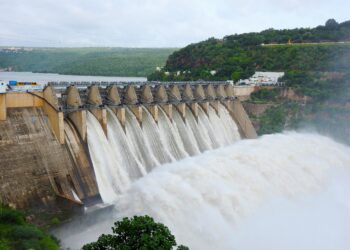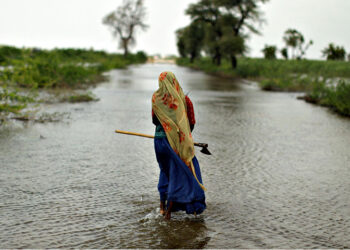The cyclone has moved away from Karachi, it has
left behind a trail of destruction, causing loss of
life and substantial property damage in Sindh
Sahir Baloch

Karachi: Cyclone Asna, originating from the Arabian Sea, has significantly impacted Pakistan‘s coastal regions, especially in Sindh and Balochistan. Although the cyclone has moved away from Karachi, it left behind a trail of destruction, causing loss of life and substantial property damage in Sindh. Meanwhile, Balochistan remains at risk of heavy rainfall and flooding until Sunday night.
Current Status of Cyclone Asna
The Pakistan Meteorological Department (PMD) issued its ninth alert on Sunday, stating that Cyclone Asna is currently located:
- 500 kilometers southeast of Karachi
- 350 kilometers south of Ormara
- 260 kilometers southeast of Gwadar
The cyclone continues to move southwest, with its intensity gradually decreasing. Karachi may experience light rain and drizzle, but the cyclone’s direct threat to the Sindh region has diminished significantly.
Impact on Sindh: Lives Lost and Property Damaged
Even though Cyclone Asna has moved away from the Sindh coast, it caused significant damage across several districts:
- Jamshoro, Dadu, and Mirpurkhas: Rain-related incidents have claimed at least nine lives due to electrocution and building collapses.
- Over 30 Injured: Heavy rains caused sewers to overflow, breached dykes, and destroyed numerous mud houses, leaving over 30 people injured. The affected areas are dealing with waterlogging and drainage problems.
Karachi’s Weather Update
In Karachi, the effects of the cyclonic storm have lessened, with Asna now 500 kilometers away from the city. According to the PMD, the cyclone has moved further southwest and will not bring significant rain or gusty winds to Karachi.
However, due to the prevailing overcast conditions, light rain or drizzle may occur. The PMD reported that morning winds blew from the northeast at a speed of 12 km/h, and sea breezes should return by evening or night. Karachi recorded a minimum temperature of 23.5°C, with a maximum of 30-32°C expected during the day. Humidity levels were around 91%.
Continued Caution for Fishermen
The PMD has allowed fishermen in Sindh to return to the sea starting Sunday, as the cyclone has moved away from the coast. However, it advised fishermen in Balochistan to avoid the open sea until September 1 due to rough sea conditions.
Impact on Balochistan: Heavy Rain and Flood Warnings
While Sindh has escaped further damage, Balochistan continues to experience severe effects from Cyclone Asna. The PMD has warned of heavy rains, thunderstorms, and strong winds (60-70 km/h) in several coastal areas, including:
- Hub, Lasbella, Awaran, Ormara, Pasni, Gwadar, Jiwani, Turbat, Panjgur, and surrounding regions until Sunday night.
These conditions could lead to waterlogging and flooding in low-lying areas along the Makran coast. The PMD also reported that sea conditions will remain rough with squally winds gusting up to 80 km/h until September 1.
Damage Assessment in Balochistan
Heavy rains and flash floods in Balochistan have caused widespread destruction:
- Road Infrastructure: Floods have washed away key routes, such as the Quetta-Chaman highway, disrupting the Afghan transit trade.
- Shelter and Livelihoods: The collapse of numerous mud houses has left hundreds of families homeless in areas like Qila Abdullah, Qila Saifullah, and Jhal Magsi. Flooding has cut off many villages in Jhal Magsi, and rescue operations are ongoing.
Emergency Response and Future Outlook
Authorities have declared a flood emergency in Chaman and other affected districts in response to the flooding and destruction. The Provincial Disaster Management Authority (PDMA) has dispatched boats, tents, and relief goods to assist stranded residents.
The PMD continues to monitor Cyclone Asna closely and will issue further advisories as needed. Although the cyclone is gradually weakening, the threat of heavy rain and flooding persists, particularly in Balochistan’s coastal areas.
Conclusion
Cyclone Asna has created significant challenges for Pakistan’s coastal regions, especially in Sindh and Balochistan. While Sindh is beginning to recover as the cyclone moves away, Balochistan still faces risks of heavy rainfall and flooding. Authorities urge residents to stay vigilant, follow advisories, and take necessary precautions in the coming days.























